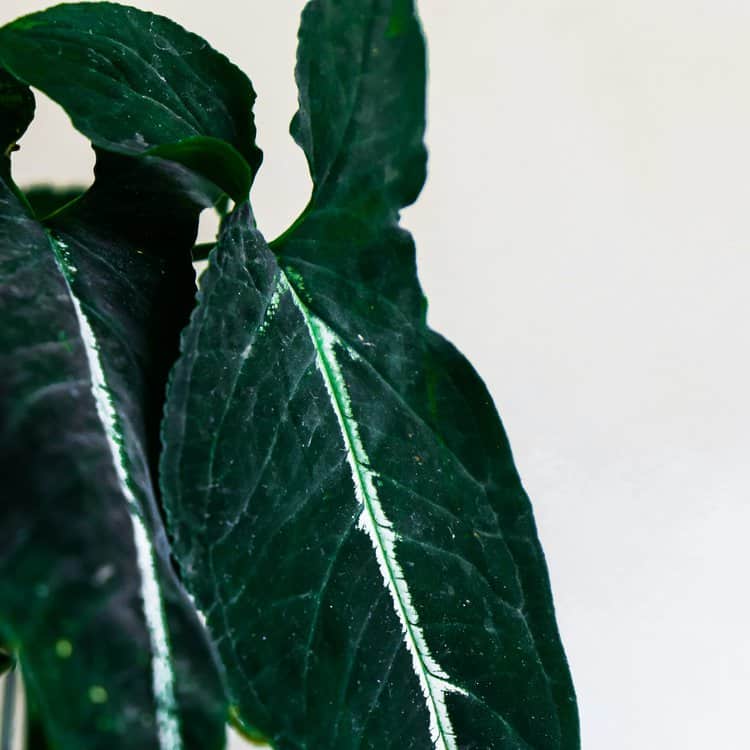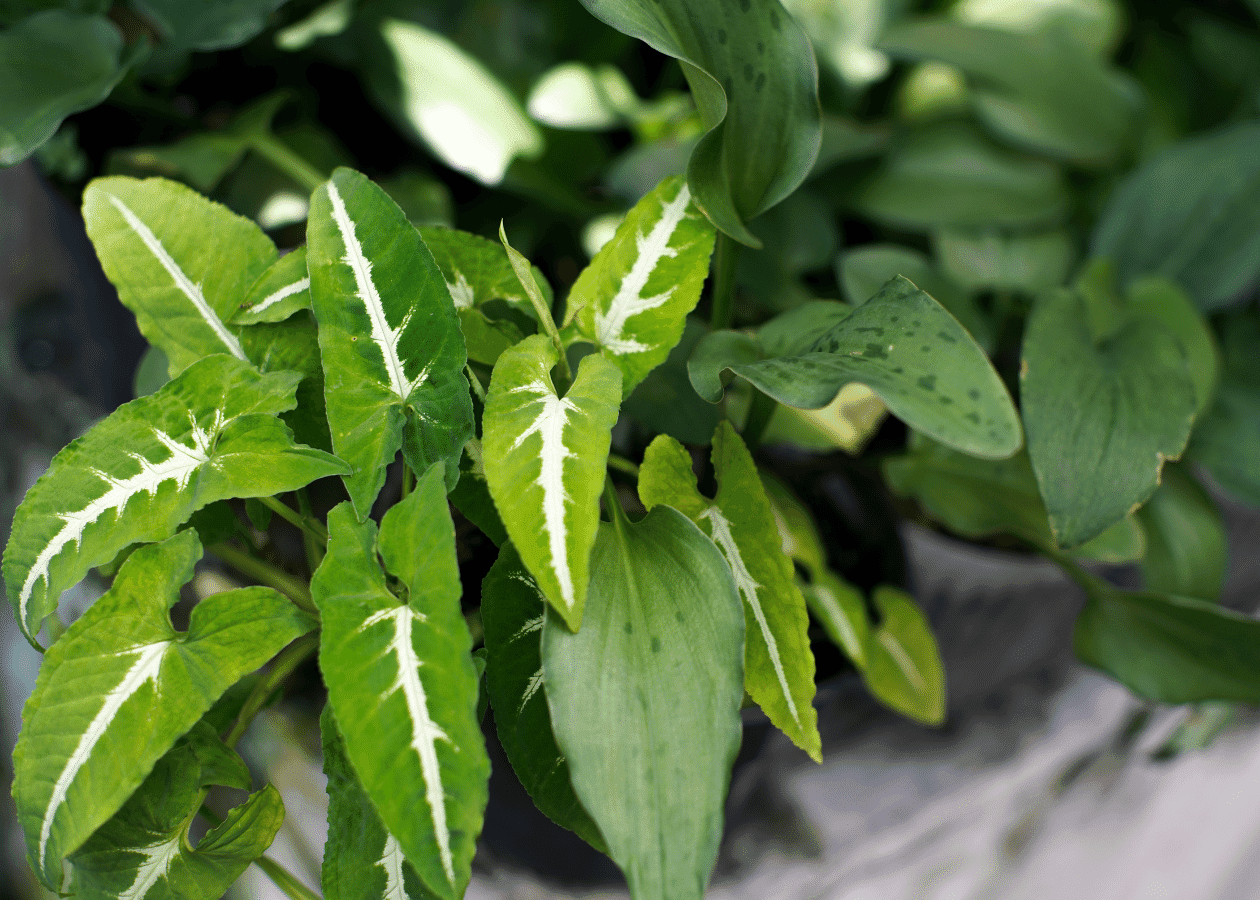Whether you are a plant novice or expert, the Syngonium rayii is a highly adaptable and easy-to-care-for tropical plant. Known for being a plant with soft velvety leaves, this species is a sturdy terrestrial hemiphyte that brightens up any space. Read on to learn more about providing expert plant care!
Table of Contents
Syngonium Rayii Overview
Syngonium rayii is a tropical plant that originates from Costa Rica and Panama. This species is also called the Velvet Syngonium rayii or the arrowhead vine due to its velvety dark green leaves shaped like arrowheads.
This terrestrial plant is a member of the Araceae family, also known as aroids, and part of the genus Syngonium. Native to the tropics, the Syngonium rayii enjoys bright indirect light, moderate watering, and warm temperatures.
Some notable relatives of the Syngonium rayii include the Syngonium podophyllum arrowhead vine varieties Emerald Gem, Trileaf Wonder, and Pink Allusion.
Syngonium types:
Emerald Gem: This variety of Syngonium sports large emerald green arrowhead leaves with light green veins.
Trileaf Wonder: This fast-growing variety has thin green arrowhead leaves and silvery veins.
Pink Allusion: Beautiful light green to pink leaves adorn this variety along with darker pink veins.
| Botanical Name | Syngonium rayii |
| Family | Araceae |
| Genus | Syngonium |
| Origin | Costa rica and Panama |
| Sunlight | Bright indirect light requirements |
| Watering | Moderate requirements |
| Soil | Well draining potting mix |
| Temperature | 60-85 degrees Fahrenheit |
| Propagation | Shoot or stolon cuttings |
| Re-Potting | Every two years |
| Pests and Diseases | Spider mites, mealy bugs, and thrips |
| Toxicity | Toxic to humans and pets |

Syngonium Rayii Features
The Syngonium rayii is a sturdy tropical species known as the arrowhead vine. This is due to the shape of the dark green velvety leaves resembling an arrowhead. The leaves grow to be around four inches wide and three inches wide.
Syngonium rayii plants grow to around eight inches high before branching out their vines horizontally as the plant matures. If left unpruned, the vines can grow around six feet long. Flowers on this species are rare if growing indoors but can happen. These blooms will be white or green and develop into red or dark brown berries.
The arrowhead plant is toxic due to calcium oxalate crystals inside the plant and should be kept away from children and pets. These crystals can induce irritation, nausea, and diarrhea.
Syngonium Care Guide
When caring for Syngonium rayii, it is important to note that while it is sturdy, its care does have requirements for successful growing. The arrowhead plant originates from tropical areas and thrives on bright indirect light and high humidity. Therefore, avoid too much direct sunlight to help protect its stunning foliage.
This species will grow successfully when planted in typical pots and hanging baskets but is also used in terrariums and vivariums to grow alongside other plants and animals. So long as the environment is suitable for this plant, it will likely thrive.
Ideal Growing Place
Like many other tropical plants, arrowhead plants prefer a warm, humid, and bright environment. If those requirements are met, the Syngonium rayii can grow successfully indoors and outdoors.
If you are a resident of Florida, it is important to grow your arrowhead vine indoors as this species is invasive and can threaten the health of other plants and animals in the ecosystem.
The Syngonium rayii shows faster growth in the spring and summer months when temperatures are higher and slower growth in the cooler fall and winter months.
Water
The Syngonium rayii prefers the soil moist but not soggy. Too much water lingering in the soil can cause harmful root rot. A general rule of thumb is to place your plant in a pot or basket with adequate drain holes to let excess water flow through.
To keep the soil moist and learn your plant’s watering schedule, check soil moisture levels often by placing two fingers into the soil. It is time to water if the soil feels about 70% dry or more. On average, your arrowhead plant will need to be watered two to three times per week in the spring and summer. In the fall and winter, growth is slower, so your plant will only need watering once a week.
Sunlight
Syngonium rayii are beautiful foliage plants that can be sensitive to too much direct sunlight. They should grow in an environment with bright indirect light to not burn the arrow-shaped leaves. East or west-facing windows have a lot of light to offer for your plant, but be sure they are not in the direct path of the light.
Temperature
The Syngonium rayii species is sturdy and can withstand a wide temperature range. The most successful growth will occur in a temperature range of 60-85 degrees Fahrenheit. As a tropical plant, it can withstand warmer temperatures more easily but is extremely sensitive to temperatures below 50 degrees.
Soil
A potting mix that is supplemented with peat is a great Syngonium soil mix to use for your arrowhead vine. The peat encourages the soil to retain moisture while still promoting draining. Adding other additions like perlite can help the soil stay aerated and the roots healthy. The plant pot should also have drainage holes for excess water to escape, which helps avoid root rot. Using perlite and peat alongside your potting mix creates a well-draining potting mix.
Humidity
Tropical plant species like the Syngonium rayii thrive in humid environments. The optimal humidity levels for these species are around 70%. However, due to the rayii’s adaptability and sturdiness, it can grow well in environments with humidity as low as 50%. A humidifier or misting technique can help provide your plant with extra moisture on dry days.
Fertilizer
Using a fertilizer for your plant can provide extra nutrients to support its growth during the warmer spring and summer months. During the growing season, give your Syngonium rayii a half-strength liquid fertilizer about once a month, and skip during the colder winter months of dormancy.
Pinching/Pruning
The Syngonium rayii is a beautiful vining species that can grow to a length of around six feet if left to its own devices. If you want your plant to vine this way, consider using a moss pole or trellis for the plant to wrap around.
If you want your plant to appear bushier and more compact, pruning your plant is easy. To prune, identify the vines you wish to trim off, and you can even use those to propagate Syngonium rayii.
Potting and Re-potting
It is recommended to repot your Syngonium rayii plant around every two years. The best time to repot is during the growth period in spring and summer. If you are happy with the size and growth of your plant, you can keep the same size pot and replace the soil. If you wish to encourage more growth, place your plant in a pot one to two inches wider than the previous, so roots have space to grow.
Growth Zone
The Syngonium rayii can be successfully grown outdoors in the USDA Plant Hardiness Zones 9-11. This geographic area includes the southern states and the west coast of the United States, where the climate is suitable for this species.
Common Pests, Toxins, Diseases & Other Problems
One of the best qualities of the Syngonium rayii is its resistance to pests and other ailments. However, your Syngonium plant could also be affected if you have other plants that are more susceptible to pests like mealy bugs, spider mites, and thrips. Treat your plant with a neem oil spray to eliminate these pests.
Another issue known to the Syngonium rayii is the yellowing of leaves caused by root rot. Be mindful of how often you water your plant and ensure your soil is well-draining. Lastly, the rayii species is toxic to humans and pets due to oxalate crystals within the plant. Be sure to use gloves when pruning or propagating.
Propagation
You can use two methods for successful Syngonium propagation: stem cuttings and stolon cuttings.
How to propagate Syngonium with stem cuttings:
- Identify a stem area at least four inches in length with healthy leaves and at least one node.
- Cut the stem about a half inch below the nodes using a sterilized knife, shears, and gloves.
- Place this cutting in warm room temperature water and allow roots to develop over the next few weeks. Once the roots are three inches or longer, they are ready to be planted into fresh soil.
Propagating by stolon cuttings is a similar process. Stolons are runners the vine sends out and appear like woody stems with aerated roots. Find a stolon that looks healthy and cut about a half inch from the mother plant, and remove any sections without leaves. Place this cutting in room temperature water allowing root growth to occur over the next few weeks before planting in the soil.
Related Article: How To Prepare Garden Soil For Next Season
Syngonium Rayii Mature Timeline
Day 1-28: Propagate your Syngonium rayii by stem cuttings or stolon cuttings and place the cuttings in water to promote new root growth. Roots will take about four weeks to grow a few inches.
Day 28+: Roots have grown at least three inches, and your cutting can now be planted in fresh soil and cared for as directed in the Syngonium rayii care guide.

Syngonium Rayii Care FAQ
Are Syngonium Rayiis Annuals or Perennials?
Syngonium rayii is a perennial species that will return season after season with the proper care.
Is Syngonium Rayii a Fast Grower?
The Syngonium rayii species is a rapidly growing vining plant. While the height caps at about eight inches tall, the vines can reach around six feet long.
Does the Syngonium Rayii Bloom?
While it is rare when grown indoors, the Syngonium rayii can bloom. If it does, it will produce white or green flowers that can develop into berries.
Is Syngonium Rayii Rare?
Syngonium rayii is considered rare because it is cultivated from wild versions in nature. It is also lesser-known that other Syngonium plants making it harder to find.
Is Syngonium Rayii Toxic to Pets and Humans?
The arrowhead plant is toxic to pets and humans due to its calcium oxalate crystals that can cause diarrhea, nausea, and irritation.
Why Are the Leaves of Syngonium Rayii Turning Yellow?
If the leaves of your Syngonium rayii plant are turning yellow, then it is likely your plant is suffering from root rot caused by overwatering.
Why Are New Leaves of Syngonium Rayii Not Unfurling?
Some reasons your new leaves are not unfurling include low humidity, water, and nutrient levels.
What Is the Difference Between Syngonium Rayii vs Wendlandii?
There are many types of Syngonium. Look to the foliage to tell the difference between rayii and wendlandii. For example, the Syngonium rayii species has smaller leaves that are a darker green than those of the Syngonium Wendlandii.
Is Syngonium Rayii a Good Air Purifier?
Syngonium plants are adept at taking in toxins and pollutants from the air and sending them to the roots to be converted into nutrients for the plant to use.
What Are the Benefits of Syngonium Rayii Plant?
The Syngonium rayii plant is admired by many due to its low maintenance, easy-care requirements, beautiful foliage, and vining tendencies.
The Bottom Line
If you are looking for a vining plant with striking foliage, then the Syngonium rayii is the one for you. It is easy to care for, sturdy, and resistant to many pests and diseases, making it a unique addition to any indoor or outdoor space!
Last Updated on August 27, 2022 by Gustaf Johansson




